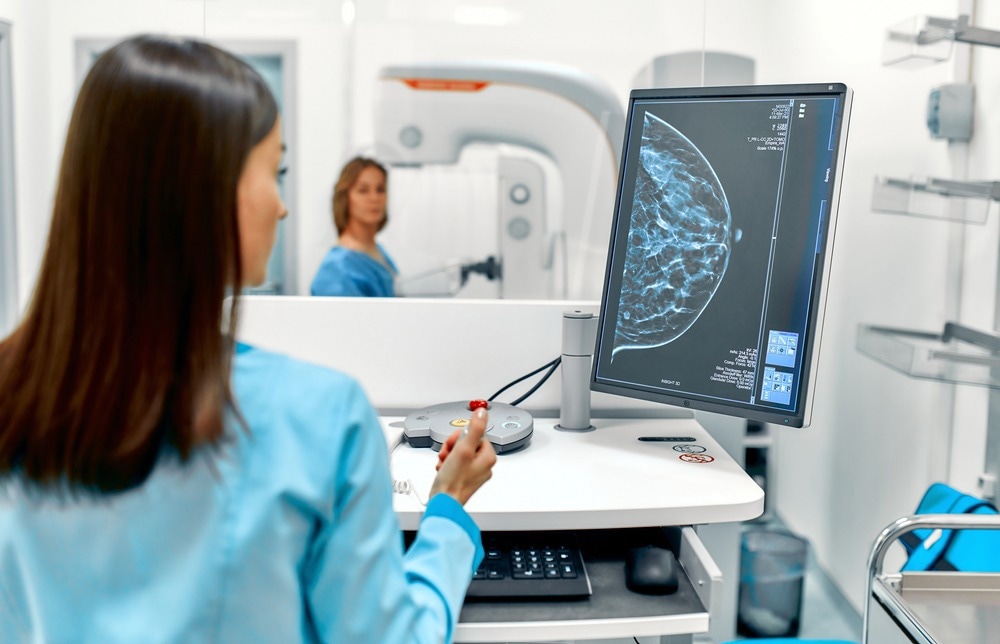In a recent study published in the journal Nature Communications, researchers used a Mendelian randomization approach to conduct a genetic association analysis of the levels of over 3,000 proteins to identify biomarkers for early breast cancer detection.
 Study: Evaluation of circulating plasma proteins in breast cancer using Mendelian randomisation. Image Credit: ORION PRODUCTION/Shutterstock.com
Study: Evaluation of circulating plasma proteins in breast cancer using Mendelian randomisation. Image Credit: ORION PRODUCTION/Shutterstock.com
Background
Although breast cancer is the most prevalent type of cancer affecting women across the world and is associated with substantial morbidity and a significant mortality rate, extensive research involving exome and genome-wide genetic association studies has discovered close to 300 genetic loci that can predict susceptibility to breast cancer. However, the role of specific variants of these genes and the mechanisms through which these loci influence the susceptibility to breast cancer remain unclear.
Compared to genome-wide association studies, a Mendelian randomization approach provides an alternative method of understanding and mapping pathways that are etiologically important in the risk and development of cancer. This approach examines genetic variants to determine the causal relationship between cancer and its modifiable. Additionally, circulating proteins in the plasma that can be precisely measured using high-throughput methods are indicators of biological processes associated with cancer and can be explored to identify potential biomarkers with etiological roles in cancer pathogenesis.
About the study
In the present study, the researchers evaluated the levels of close to 3000 proteins from plasma samples of women registered in the Karolinska Mammography Project. The sample set consisted of 299 women who had been diagnosed with breast cancer within two years of having provided blood samples for the study and an equal number of random controls who had not been diagnosed with breast cancer at the time of the study.
While there were no significant differences in factors such as body mass index, receipt of hormone replacement therapy, or median age between the breast cancer cases and cancer-free controls, the number of women who were smokers or who had a family history of breast cancer was higher among the cases.
Measurements of protein levels were used for a genetic association analysis to identify cis-acting protein quantitative trait loci, which were then used as instrumental variables in the Mendelian randomization analysis. The Mendelian randomization analysis to determine the risk of breast cancer was carried out through a case-controlled meta-analysis of the Breast Cancer Association Consortium, and the findings were then replicated using a second case-controlled meta-analysis of breast cancer risk using the United Kingdom (U.K.) Biobank and FinnGen from Finland.
Significant proteins identified through these Mendelian randomization analyses were visualized and evaluated for genetic associations for breast cancer and colocalization of the proteins. Furthermore, potential etiological relationships between these proteins and emerging and existing risk factors for breast cancer were also examined using the Mendelian randomization approach.
An affinity proteomics approach, using Olink’s Proximity Extension Assay Explore I and II panels, was employed to analyze the plasma samples. A regression model was then implemented to evaluate the association between incident breast cancer and protein levels in the plasma, as well as between the protein levels and clinical characteristics of the participants.
Results
The results reported that five proteins were identified through the Mendelian randomization analyses to play a potentially etiological role in the risk of breast cancer, which had been confirmed through analyses of the independent cohorts. These five proteins were CD160, layilin (LAYN), 2’-deoxynucleoside 5’-phosphate N-hydrolase 1 (DNPH1), toll-like receptor 1 (TLR1), and leucine-rich repeat containing 37 member A2 (LRRC37A2).
Genetically higher levels of TLR-1, DNPH1, and LAYN and lower levels of LRRC37A2 and CD160 were found to correlate with an increase in breast cancer risk. Higher LRRC37A2 levels were also linked to age at the onset of menstruation, providing evidence for its role in the risk of breast cancer. Additionally, the enzyme encoded by the DNPH1 gene is involved in nucleotide metabolism and is also targeted by the transcription factor E twenty-six variant 1 (ETV1) that is expressed in breast cancer tumors.
CD160 is a receptor expressed in most immune cells, such as natural killer cells (NK cells), and is linked to cytokine production. Studies involving patients with hepatocellular carcinoma have shown impaired NK cell functions associated with lower levels of CD160 expression. Additionally, Layilin, encoded by LAYN, is an integral membrane and a talin-binding transmembrane protein that has an essential role in cell motility and adhesion and is a receptor for hyaluronic acid. Elevated levels of hyaluronic acid have been found in the tumor microenvironment of various types of cancers, including breast cancer.
Conclusions
Overall, the findings revealed that a Mendelian randomization approach to analyze the levels of a wide range of proteins circulating in the plasma was effective in identifying five genes that played a potentially causal role in increasing the risk of breast cancer. Higher expression levels of TLR-1, DNPH1, and LAYN and lower expression of LRRC37A2 and CD160 were found to be associated with an increase in breast cancer risk. Further research is required to examine whether these biomarkers could be potential drug targets.